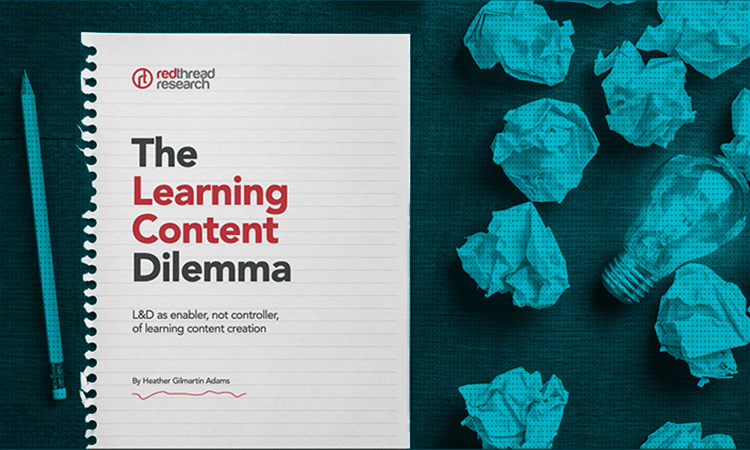3 big digital learning trends, according to experts
5 minute read
Last year saw the digital learning landscape become a place of exploration. Learning and Development (L&D) teams got busy testing the latest tech, exploring fresh approaches and bridging new skill gaps. As we move out of this phase of experimentation, what lies ahead? We’ve tapped into the minds of L&D experts to find out. Read on to discover the 3 corporate elearning trends that they see shaping L&D in 2025.

New elearning, process, and tech trends for 2025
Following a year of experimentation, L&D’s key challenges and opportunities are coming into sharper focus. And that means it’s time to start making informed decisions. What strategies will meet organizations’ evolving needs? How can technology be used to deliver impact? What does effective learning look like in the age of Artificial Intelligence (AI)? What part do internal experts play in this new digital learning landscape?
We wanted to discover how teams are planning to deliver impact in 2025, so we surveyed 300+ professionals and 12 learning experts and influencers to get their unique insights on the year ahead for L&D.
3 corporate elearning trends to watch in 2025
Years of rapid change within the elearning industry have offered lots of new L&D insights. Here are 3 corporate elearning trends experts expect to see going to the next level in the coming year – dive in so you can get ahead of the curve.
Want to get even more of a head start on your peers? The State of Digital Learning Report gives you access to not only corporate elearning trends, but expert insights and interviews as well as practical downloads and resources to help you succeed.
Trend #1 Meaningful AI
“AI has already made its mark, and its influence will only deepen. Whether we’re talking about this year or beyond, organizational processes will become more defined.”
Lloyd Dean, Senior Global Learning and Development Manager, AXA
Just like employees, L&D teams are exploring how new tech can help them meet learning needs in 2025. In fact, 90% of L&D professionals surveyed see technology being the key trend shaping the future of digital learning in the next 3-5 years. So how are they looking to use this tech?
- 60% are looking to use AI to assist in content creation
- 11% see AI playing a significant role in personalization
- 11% want to use AI to assist with analytics and reporting
“As digital transformation accelerates, there’s a tendency to adopt new technologies – especially with AI tools flooding the market – simply because they’re trending, rather than because they serve a clear learning need. Instead of focusing on the technology itself, focus on the experience it enables for learners and what business problems we’re trying to solve.”
Stella Lee, Director, Paradox Learning
Experts have highlighted that there’s a risk that L&D end up using AI to deliver content rather than impact. AI content quality, accuracy, and efficiency became an increasing issue in 2024. Using this new technology with intention is the key to its success.
“While it’s tempting to use all these new AI tools to just churn out more and more content, don’t do it! Let’s not create a digital learning version of the Great Pacific Garbage Patch.”
Cammy Bean, Senior Solutions Consultant, Kineo
Trend #2 SME-generated content
“SMEs are the one thing AI cannot replicate, especially when there’s industry and company-specific knowledge in their brains. This is where we have to make it as easy as possible to make their insights locatable, usable, and relevant.”
Lori Niles-Hofmann, Senior Learning EdTech Transformation Strategist, NilesNolen
SMEs play a key part in every learning project. They’re your gateway to content and audience. But they can play a much bigger role.
More and more SMEs are being called upon to generate learning content.
- 35% of L&D teams surveyed are using a hybrid mix of:
- Centralized (with a core team of learning design experts), and
- Decentralized (where learning is generated within departments or regions, sometimes without any learning design input)
- 27% are using a fully ground-up or decentralized L&D structure
“Our research shows more and more SMEs, new to learning design, are getting involved in the creation of learning materials. Sometimes in partnership with a central learning design team, often without. Some governance and framework is needed to ensure what’s produced is of the right quality. Provide simple processes, templates, easy authoring tools, good examples, checks and balances, and human/AI design guidance to support this initiative.”
Kirsty Greany, Head of Learning Strategy, Elucidat
If these new structures are going to be effective, L&D teams need to build the necessary capabilities, workflows, and culture to create engaging and impactful learning experiences.
“Rather than creating content in isolation, SMEs [and L&D need a] true partnership, because this will make content more relevant and dynamic, with SMEs positioned as strategic contributors rather than isolated knowledge holders.”
Heidi Kirby, Learning and Development Consultant and Coach, Useful Stuff
Trend #3 Skills focus
“Companies are pivoting faster than ever before and L&D can no longer be in a reactive position. They need an understanding of how the skills-based transformation is happening at their organization.”
Lori Niles-Hofmann, Senior Learning EdTech Transformation Strategist, NilesNolen
To truly thrive, employees and businesses need to harness the right skills at the right time and for the right work. So, it’s not surprising that may L&D teams are getting more skills focused.
- 27% of L&D teams are exploring a shift from traditional job roles to a skills-based approach in the next few years.
- 21% are already making the shift or planning to do so soon.
“We need to recognize the importance of building skills-based organizations and moving away from traditional job roles. This approach will give organizations more flexibility to connect with the business and our learners.”
Bianca Baumann, VP, Learning Solutions & Innovation, Ardent
Tomorrow’s success requires skills agility. But, according to LinkedIn Workplace Learning Report, most weighty learning initiatives stall at the early stages. Fewer than 5% advanced far enough to measure success. With many organizations making the move to a skills-based approach in 2025, we should see this change.
‘’Think about data differently. Align learning projects directly with business goals, ensuring that programs not only support skill-building but also drive measurable impact.’’
Heidi Kirby, Learning and Development Consultant and Coach, Useful Stuff
Corporate elearning trends in summary
Taking onboard the learning from the previous year’s experiments is critical to L&D’s success in 2025. Ensure you stay ahead with the 3 key corporate elearning trends experts see creating value for your business and employees:
- Use AI meaningfully – Leveraging new technology to deliver learning impact securely, ethically, and efficiently rather than just producing content.
- Empower SMEs to generate learning content – Recognizing that these internal experts are more crucial than ever for accurate, up-to-date, and impactful learning.
- Refocus on skills – Supporting the business in the shift from role-based structures to being a truly skills-based organization.
Putting it into action
Eager to explore strategies and best practices that your expert peers are implementing this year? Access the State of Digital Learning Report where you can tap into the minds of your L&D peers and learning experts, compare approaches, and get prepared for the year ahead..




